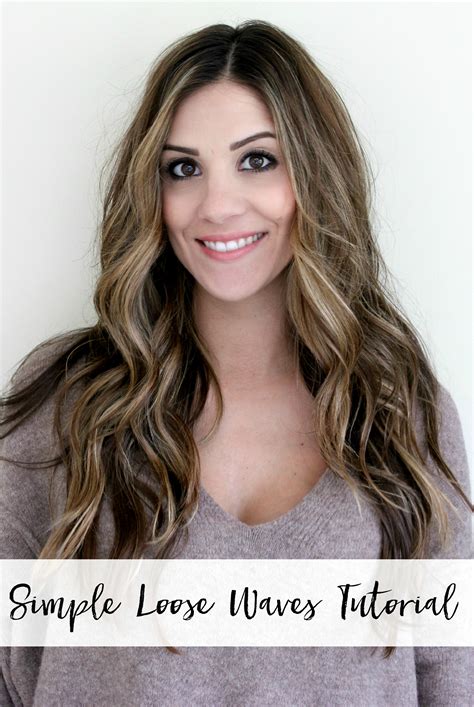Introduction
Loose wave hair, characterized by its soft, voluminous curls, has become a highly sought-after hairstyle due to its versatility and flattering appearance. With the growing popularity of loose wave extensions, many individuals are embracing the opportunity to achieve this coveted look without having to wait for their natural hair to grow.

Choosing Loose Wave Hair
When selecting loose wave hair, several factors must be considered to ensure a natural and seamless look.
- Length: Loose wave hair can range in length from short to long, so choose a length that complements your facial shape and height.
- Density: The density of loose wave hair refers to the amount of hair per weft. Choose a density that provides sufficient volume without appearing too thick or thin.
- Color: Loose wave hair extensions come in a wide range of colors, including natural shades, highlights, and ombre. Select a color that matches your natural hair or opt for a bolder hue for a transformative look.
- Quality: The quality of loose wave hair varies depending on the type of hair used and the manufacturing process. Look for hair that is soft, tangle-free, and free of damage.
Types of Loose Wave Hair
There are several types of loose wave hair available, each with its unique benefits:
Remy Hair: Remy hair is sourced from one donor and maintains the natural direction of the hair cuticles. This ensures minimal tangling and a longer lifespan.
Virgin Hair: Virgin hair has never been chemically treated or colored. It is the most expensive type of hair but also the most durable and natural-looking.
Synthetic Hair: Synthetic hair is created from synthetic fibers and is the most affordable option. It is not as durable as human hair but can provide a temporary alternative.
Benefits of Loose Wave Hair
Loose wave hair offers numerous benefits that have contributed to its popularity:
- Volume: Loose waves create instant volume and fullness, making it ideal for those with fine or thin hair.
- Versatility: Loose wave hair can be styled in a variety of ways, including beachy waves, loose curls, and even braids.
- Low Maintenance: Loose wave hair requires minimal maintenance compared to other hair types. It can be washed and styled less frequently.
- Flattering: Loose waves are universally flattering, highlighting your facial features and adding a touch of glamour.
Pros and Cons of Loose Wave Hair
As with any hair type, loose wave hair has its advantages and disadvantages:
Pros:
- Effortlessly glamorous look
- Adds volume and fullness
- Versatile styling options
- Low maintenance
Cons:
- Can be more expensive than other hair types
- May require occasional touch-ups
- May struggle with tangling if not properly cared for
How to Maintain Loose Wave Hair
To maintain the beauty and lifespan of your loose wave hair, follow these care tips:
- Brush your hair gently with a wide-toothed comb or paddle brush to avoid breakage.
- Wash your hair less frequently, using a sulfate-free shampoo and conditioner.
- Apply a leave-in conditioner or hair moisturizer to keep your hair hydrated.
- Avoid using heat styling tools as much as possible.
- If using heat styling tools, apply a heat protectant spray beforehand.
- Trim your hair regularly to remove split ends and maintain a healthy appearance.
Conclusion
Loose wave hair has emerged as a top choice for those seeking effortless glamour and volume. Whether you opt for human hair extensions or synthetic alternatives, loose wave hair offers a transformative look that is both versatile and low maintenance. By following the care tips provided, you can maintain the beauty and longevity of your loose wave hair, ensuring a stunning appearance for years to come.
Additional Insights
Innovative Applications
Loose wave hair has inspired a range of creative applications beyond traditional hairstyles, including:
- Hairpieces: Loose wave hairpieces can be added to updos and half-up styles for instant texture and volume.
- Clip-ins: Loose wave clip-ins provide a quick and easy way to add length and fullness to short or thin hair.
- Toppers: Loose wave toppers conceal thinning hair and restore natural volume without major surgery or medication.
Market Trends
According to a study by Grand View Research, the global market for hair extensions is projected to reach $12.84 billion by 2028. Loose wave hair is a significant driver of this growth due to its popularity among consumers of all ages.
Health Considerations
While loose wave hair extensions are generally safe to use, it is important to consult with a healthcare professional if you have any underlying hair or scalp conditions. Improper installation or care can lead to hair loss or other complications.
Tables for Enhanced Understanding
Table 1: Types of Loose Wave Hair
| Type | Description |
|---|---|
| Remy Hair | Sourced from one donor with natural hair cuticles |
| Virgin Hair | Never chemically treated or colored |
| Synthetic Hair | Created from synthetic fibers |
Table 2: Benefits of Loose Wave Hair
| Benefit | Description |
|---|---|
| Volume | Adds instant volume and fullness |
| Versatility | Can be styled in various ways |
| Low Maintenance | Requires minimal maintenance |
| Flattering | Universally flattering, highlighting facial features |
Table 3: Care Tips for Loose Wave Hair
| Step | Action |
|---|---|
| Brushing | Use a wide-toothed comb or paddle brush gently |
| Washing | Use a sulfate-free shampoo and conditioner, wash less frequently |
| Moisturizing | Apply a leave-in conditioner or hair moisturizer |
| Heat Styling | Use heat protectant spray and avoid excessive use |
| Trimming | Regularly trim split ends |
Table 4: Innovative Applications for Loose Wave Hair
| Application | Description |
|---|---|
| Hairpieces | Add texture and volume to updos and half-up styles |
| Clip-ins | Quick and easy way to add length and fullness |
| Toppers | Conceal thinning hair and restore volume without surgery or medication |
